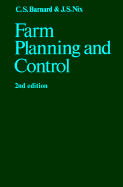
A comprehensive treatment of farm business and control, with many examples drawn from farming practice.
Although there are many motives for farming, the achievement of a worthwhile financial return, coupled with a good standard of living, ranks high among them. This implies the need for sound business organisation – the more so as holdings become larger, more specialised and more capital intensive. The present book offers a comprehensive treatment of farm business organisation and control. Although designed primarily as an intermediate text for students in universities and agricultural colleges, it is of interest and value to all those concerned with farm business, including business advisers, land agents, accountants and bank managers. The book’s wide coverage is made possible by a mainly non-mathematical presentation coupled with a liberal use of examples drawn from farming practice. The book is divided into four parts: the organisation of resources, the organisation of enterprises, the combination of enterprises and the control of resources and enterprises. The overtaking theme is that, in order to make the most economic use of the resources at his disposal, the farmer has to decide what resources to use, how to organise their use within individual enterprises and how to combine the enterprises into an integrated farming system. Lastly, if these efforts are not to be largely wasted, he must initiate the keeping of suitable records to provide both planning data and a system of checks and controls when his plans are put into practice.
Notice to readers Preface to the first edition Preface to the second edition Selected metric conversion factors Part I. The Organisation of Resources:1. The planning environment and the managerial function 2. Basic principles and concepts of planning 3. The organisation of capital – general 4. The organisation of capital – machinery, buildings and land 5. The organisation of labour Part II. The Organisation of Enterprises:6. An introduction to enterprise organisation 7. Livestock yield and fixed costs 8. Yield, variable costs and optimal feed conversion 9. The selection of feedstuffs 10. The influence of season on livestock production 11. The provision of replacements 12. Crops and cropping Part III. The Combination of Enterprises:13. Principles and procedures in planning enterprise combination 14. Budgeting and programme planning 15. Linear programming 16. Uncertainty and farm organisation and planning 17. Further programming techniques 18. Matrix construction Part IV. The Control of Resources and Enterprises:19. Data recording 20. Data analysis 21. Methods of control Index.
Although there are many motives for farming, the achievement of a worthwhile financial return, coupled with a good standard of living, ranks high among them. This implies the need for sound business organisation – the more so as holdings become larger, more specialised and more capital intensive. The present book offers a comprehensive treatment of farm business organisation and control. Although designed primarily as an intermediate text for students in universities and agricultural colleges, it is of interest and value to all those concerned with farm business, including business advisers, land agents, accountants and bank managers. The book’s wide coverage is made possible by a mainly non-mathematical presentation coupled with a liberal use of examples drawn from farming practice. The book is divided into four parts: the organisation of resources, the organisation of enterprises, the combination of enterprises and the control of resources and enterprises. The overtaking theme is that, in order to make the most economic use of the resources at his disposal, the farmer has to decide what resources to use, how to organise their use within individual enterprises and how to combine the enterprises into an integrated farming system. Lastly, if these efforts are not to be largely wasted, he must initiate the keeping of suitable records to provide both planning data and a system of checks and controls when his plans are put into practice.

